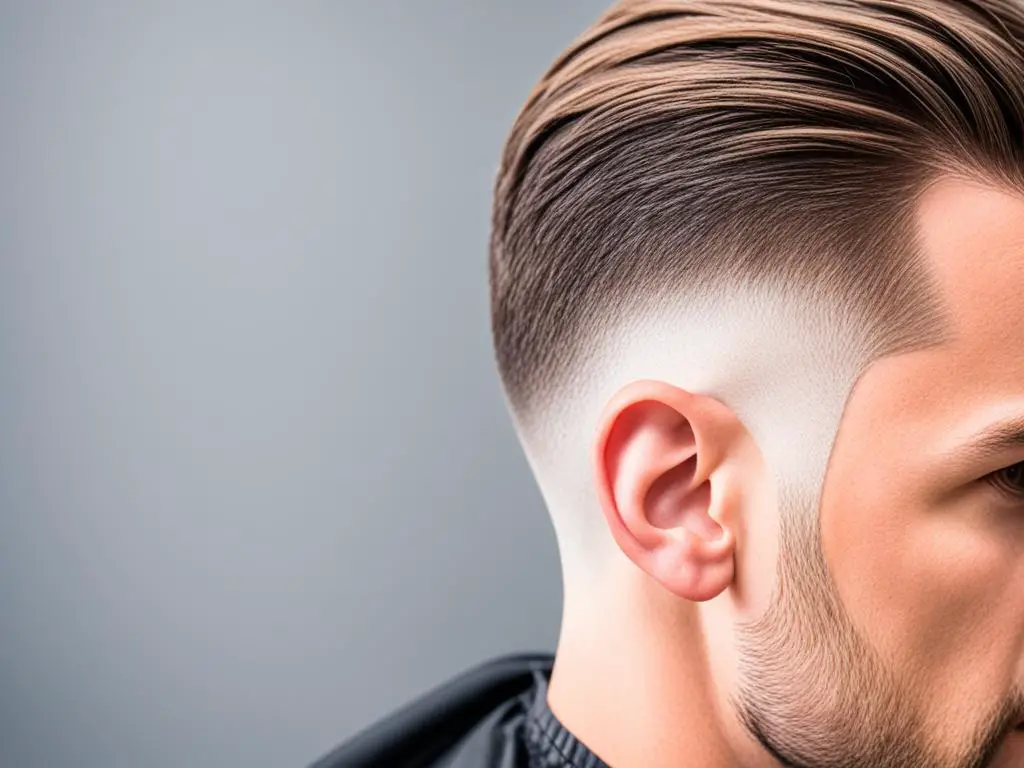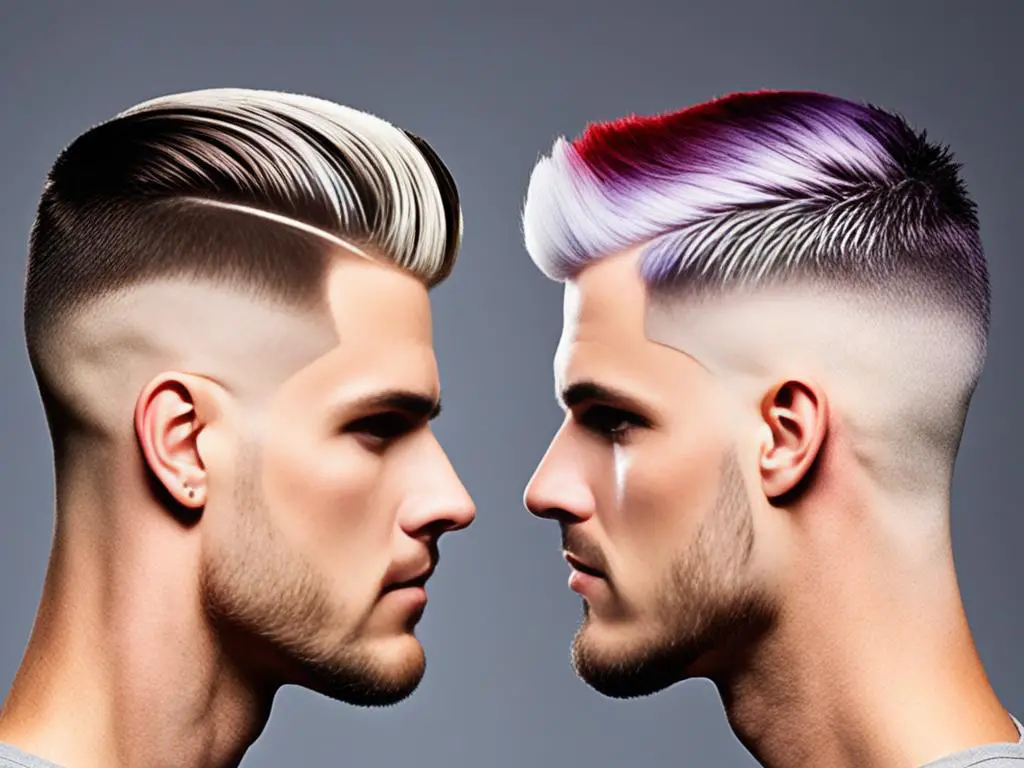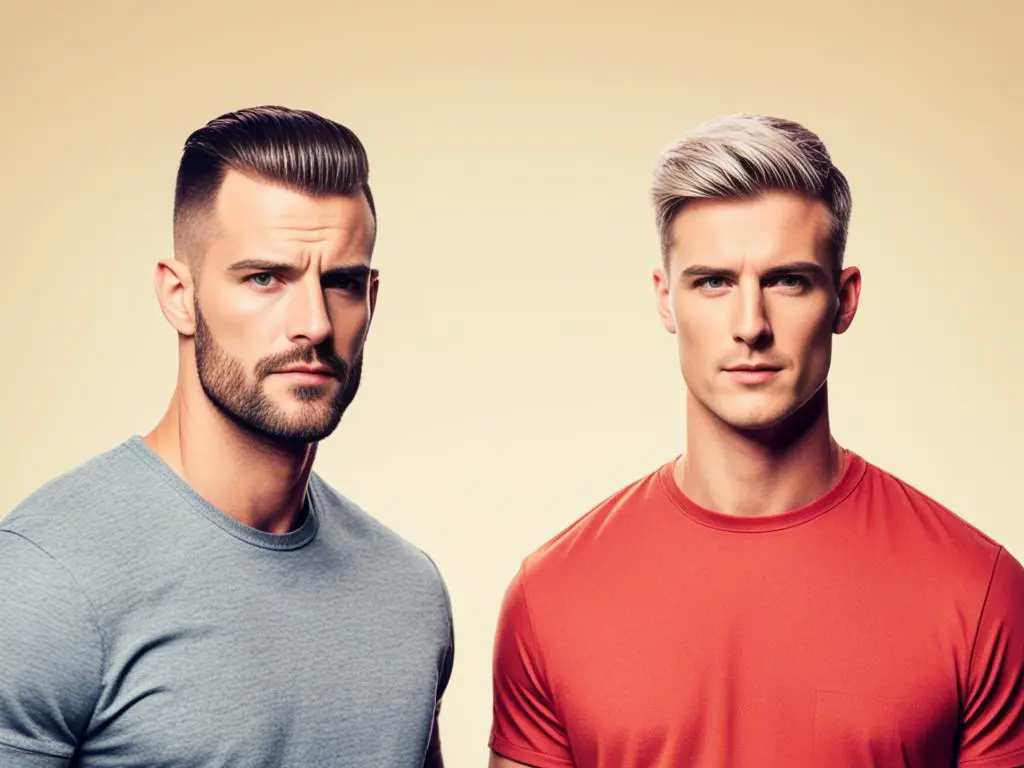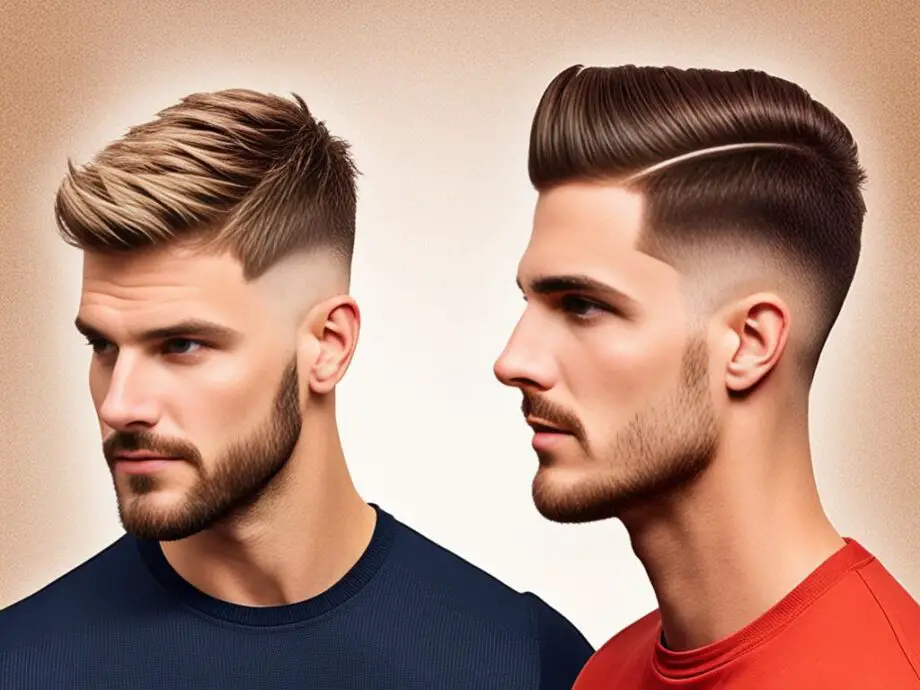Are you looking to switch up your hairstyle? Fade haircuts for men have been all the rage lately, with their clean and modern look. But when it comes to fade haircuts, there are various types to choose from, including the 0 fade and the skin fade.
In this article, we will explore the key differences between the 0 fade and skin fade haircuts, helping you make an informed decision about which style suits you best. We will also delve into the world of fade haircuts, discussing the various types of fades that exist.
Key Takeaways:
- The 0 fade and skin fade are two popular haircut styles for men.
- A 0 fade haircut features a sharp transition from the sides and back to longer hair on top.
- A skin fade, on the other hand, gradually fades from shorter hair at the neckline to longer hair on top.
- The choice between a 0 fade and skin fade depends on personal preference and desired style.
- Understanding the different types of fades can help you communicate your desired haircut to your barber.
Understanding the 0 Fade
In this section, we will dive into the details of a 0 fade haircut. A 0 fade, also known as a skin-tight fade or a zero fade, is a popular haircut choice for men. It offers a clean and edgy look, with a sharp contrast between the hair on top and the sides.
But what exactly does it mean to have a 0 fade? Well, a 0 fade refers to the length of the hair on the sides and back of the head. It involves shaving the hair down to the skin, resulting in a seamless blend with no visible hairline. The hair gradually fades from the longer hair on top to no hair at all on the sides and back.
Achieving a 0 fade requires the expertise of a skilled barber or hairstylist. They will use clippers to gradually adjust the blade length from higher numbers to create the desired fade effect. Precision and attention to detail are crucial to achieving a clean and well-defined look.
The overall appearance of a 0 fade is sleek and modern. It accentuates the facial features and adds a touch of sophistication to any hairstyle. Whether you prefer a short buzz cut on top, a textured crop, or a pompadour, a 0 fade can complement various hair lengths and styles.
By opting for a 0 fade, you can enjoy a low-maintenance haircut that requires minimal styling. It looks sharp and effortlessly cool with little to no effort. Plus, it’s versatile enough to suit different face shapes and hair types.
If you’re looking for a bold and statement-making haircut, the 0 fade might be the perfect choice for you. Its clean lines and defined shape make it a trendy option that never goes out of style. So, if you’re ready to take your hairstyle to the next level, consider the 0 fade for a fresh and fashionable look.
The Allure of the Skin Fade
When it comes to fade haircuts for men, the skin fade has gained immense popularity in recent years. This haircut offers a sleek and stylish look that is often preferred by those who want a clean-cut appearance with a hint of edginess. The skin fade sets itself apart from the 0 fade with its unique features and gives men an opportunity to express their individual style.
The skin fade is characterized by a gradual taper from longer hair at the top to a very short length or even a completely shaved appearance at the sides and back of the head. This gradual fade creates a seamless blend that highlights the longer hair on top, creating a striking contrast that adds depth and dimension to the overall hairstyle.

The skin fade is known for its versatility, as it can be customized to suit various preferences and hair types. Whether you have straight, curly, or wavy hair, the skin fade haircut can enhance your natural texture and create a polished look. Additionally, the skin fade offers flexibility in terms of styling options, allowing you to experiment with different lengths and styling products for a personalized touch.
Benefits of the Skin Fade
One of the key advantages of the skin fade is its low maintenance nature. With shorter sides and back, the skin fade requires less frequent trips to the barber for touch-ups compared to other fade haircuts. This makes it an ideal choice for individuals who prefer a stylish but hassle-free hairstyle.
Another benefit of the skin fade is its ability to complement various face shapes. Whether you have a round, square, oval, or heart-shaped face, the skin fade can be tailored to accentuate your facial features and create a balanced look. This versatility is a major reason why the skin fade continues to be a popular choice among men of all ages.
The skin fade offers a timeless and elegant aesthetic that suits any occasion. Whether you’re heading to the office, a casual outing, or a formal event, the skin fade haircut adds a touch of sophistication to your overall appearance.
It’s worth noting that maintaining a skin fade requires regular upkeep to keep it looking fresh and sharp. This typically involves scheduling barber appointments every few weeks to maintain the desired fade length and ensure a well-groomed look.
Exploring Skin Fade Variations
Within the realm of skin fades, there are various subcategories that offer unique styling options. Some popular variations include:
- Bald Fade: This variation features a completely shaved appearance at the sides and back, creating a seamless blend with the longer hair on top.
- High Fade: With a high fade, the hair is tapered very close to the crown, creating a bold and dramatic contrast between the longer hair on top and the shorter sides.
- Mid Fade: The mid fade falls somewhere between the high and low fade, creating a gradual blend that adds subtle definition to the hairstyle.
| Skin Fade Variation | Description |
|---|---|
| Bald Fade | A sleek and clean look with a completely shaved appearance at the sides and back. |
| High Fade | A bold and eye-catching contrast between the longer hair on top and the closely tapered sides. |
| Mid Fade | A gradual blend that adds subtle definition to the hairstyle. |
These variations allow you to further personalize your skin fade haircut and create a style that suits your taste and preferences.
Now that you have a better understanding of the allure of the skin fade, you can confidently explore this haircut and its variants to find a style that speaks to you. Whether you opt for a low-maintenance look or a bold and attention-grabbing style, the skin fade offers endless possibilities for men seeking a trendy and sophisticated haircut.
Key Differences: 0 Fade vs Skin Fade
When it comes to fade haircuts, two popular options that often get compared are the 0 fade and the skin fade. While they share some similarities, there are key differences in length, blending, and overall style. Additionally, there are other variations of fades, such as the low fade, high fade, bald fade, and drop fade, each offering its own unique appeal. Let’s explore these differences in more detail.
0 Fade
The 0 fade is characterized by a very short length, typically achieved by using a clipper without a guard. This results in a shaved appearance, giving a clean and bold look. The 0 fade is often chosen by individuals who prefer a minimalistic and edgy style. It provides a sharp contrast between the hair and the skin, creating a distinctive visual impact.
Skin Fade
On the other hand, the skin fade involves gradually tapering the hair down to the skin. This creates a smooth transition, with the hair gradually becoming shorter towards the neckline. The skin fade offers a more polished and subtle look compared to the 0 fade. It provides a gradual gradient effect, blending the hair seamlessly with the skin, resulting in a more refined appearance.
Now let’s take a closer look at the other related fade haircuts:
- Low Fade: The low fade starts the tapering process just above the ears, creating a subtle and gradual blend.
- High Fade: The high fade starts the tapering process closer to the temples, creating a more pronounced contrast between the longer hair on top and the shorter sides.
- Bald Fade: Also known as a skin fade, the bald fade is a more extreme version where the hair is tapered down to completely blend with the skin, leaving no visible hair.
- Drop Fade: The drop fade features a curved tapering effect, with the hair dropping lower towards the back of the head for a unique and stylish look.
By understanding the distinctions among these various fades, you can choose the one that best suits your individual style and preferences. Whether you prefer a bold and sharp 0 fade or a smooth and polished skin fade, there is a fade haircut that will help you achieve the desired look.

With the key differences between the 0 fade and skin fade outlined, you now have a better understanding of these popular haircut styles. In the next section, we will briefly explore the distinctions between a buzz cut and a crew cut, as well as the differences between an undercut and a fade.
Buzz Cut vs Crew Cut: Related Haircut Comparisons
When it comes to short hairstyles, two options that often come to mind are the buzz cut and the crew cut. While both hairstyles offer low-maintenance and stylish looks, there are distinct differences between them. Additionally, another comparison that frequently arises in haircut discussions is the undercut vs fade. In this section, we will explore these haircut comparisons to help you understand which style may be the right choice for you.
Buzz Cut:
The buzz cut is a classic and timeless hairstyle that offers a clean and neat appearance. It is characterized by short hair all around the head, usually achieved by using clippers with no attachments. This haircut is known for its simplicity and versatility, making it a popular choice among men with varying hair types and face shapes. The length of the buzz cut can vary, allowing you to choose a style that suits your preferences and desired level of maintenance. Whether you opt for a short buzz cut or a slightly longer one, this hairstyle offers a sleek and edgy look.
Crew Cut:
The crew cut is another short hairstyle that offers a polished and professional appearance. It is typically achieved by cutting the hair shorter on the sides and slightly longer on top. The length on top can vary, giving you the flexibility to customize your crew cut according to your style and personal preferences. This haircut enhances the natural texture and volume of the hair, creating a well-groomed and refined look. The crew cut is a versatile option that can be styled in various ways to suit different occasions and outfits.
Undercut vs Fade:
Now, let’s explore the difference between an undercut and a fade. Both hairstyles involve cutting the hair shorter on the sides and back, but they differ in how the transition is achieved.
The undercut is characterized by a sharp contrast between the longer hair on top and the shaved or closely cut sides and back. This creates a bold and dramatic look, emphasizing the length and volume on the upper part of the head. The undercut offers a trendy and edgy appearance that can be customized with different lengths and textures.
On the other hand, the fade is a gradual transition from longer hair to shorter hair, creating a seamless and blended look. The fade haircut is achieved by fading the hair length from the bottom up, resulting in a subtle gradient effect. This style offers a sleek and polished look that suits a wide range of hair types and face shapes. Fades can also be customized with different lengths and tapering techniques to achieve various levels of contrast.
| Buzz Cut | Crew Cut |
|---|---|
| Short hair all around | Short sides and longer top |
| Low maintenance | Low maintenance |
| Versatile and simple | Polished and refined |
| Undercut | Fade |
|---|---|
| Sharp contrast between long top and shaved sides | Gradual transition from longer to shorter hair |
| Bold and dramatic look | Seamless and blended appearance |
| Trendy and edgy style | Sleek and polished look |
Ultimately, the choice between a buzz cut, crew cut, undercut, or fade depends on your personal style, hair texture, and maintenance preferences. Consider consulting with a professional hairstylist who can guide you in selecting a haircut that complements your features and aligns with your desired look.

Conclusion
In conclusion, we have explored the differences between a 0 fade and a skin fade haircut. We discussed the appeal of fade haircuts for men and the various types of fades that exist. We examined the specific characteristics of a 0 fade haircut, understanding its unique features and how it is achieved.
We also delved into the allure of the skin fade, highlighting its popularity and the distinct traits that set it apart from a 0 fade. We compared and contrasted these two haircut styles, exploring variations in length, blending, and overall aesthetic. Additionally, we touched upon related fades such as low fade, high fade, bald fade, and drop fade to provide a comprehensive understanding of fade haircuts.
Furthermore, we briefly discussed the differences between a taper and a fade haircut. While both styles involve a gradual change in length, a taper typically maintains more length at the top and gradually shortens towards the sides and back. On the other hand, a fade involves a more pronounced decrease in length, resulting in a more gradual or abrupt transition from longer to shorter hair.
Ultimately, it is important to choose a haircut that best suits your personal style and preferences. Whether you opt for a 0 fade, skin fade, taper, or any other haircut style, make sure to consult with a professional stylist to achieve the desired look. Experimenting with different hairstyles can be a fun and empowering way to express your individuality.
